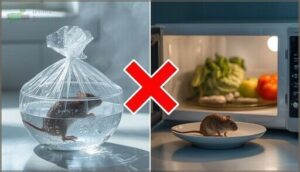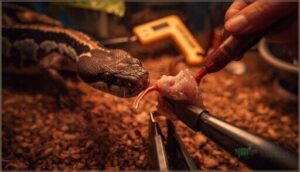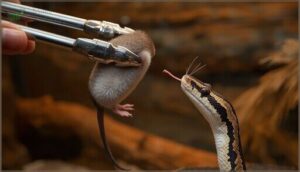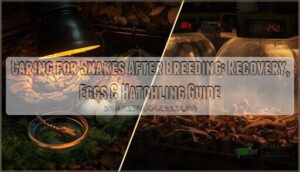This site is supported by our readers. We may earn a commission, at no cost to you, if you purchase through links.

Yes, snakes can safely eat frozen mice—in fact, most veterinarians and experienced reptile keepers recommend them over live prey. Frozen mice eliminate the risk of bites and scratches that live rodents can inflict on your snake, and they greatly reduce the chance of transmitting parasites or disease.
Beyond safety, frozen prey offers consistent nutrition and considerable convenience. You can buy in bulk, store them for months, and thaw exactly what you need when feeding time arrives.
The key lies in proper selection, storage, and thawing techniques. When you match the prey size to your snake’s girth, store mice correctly, and warm them to the right temperature, your snake won’t know the difference between frozen and fresh—and you’ll enjoy peace of mind knowing you’re providing a safer, healthier meal.
Table Of Contents
- Key Takeaways
- Can Snakes Eat Frozen Mice?
- Benefits of Feeding Frozen Mice
- Choosing The Right Frozen Mouse Size
- Storing Frozen Mice Safely
- Thawing and Feeding Techniques
- Addressing Feeding Challenges
- Frequently Asked Questions (FAQs)
- How do you get a snake to eat a frozen mouse?
- Can snakes eat frozen feeder mice?
- Are frozen mice safe for snakes & carnivorous pets?
- How do you feed frozen mice?
- Do corn snakes eat frozen mice?
- Are frozen mice safe for slithery snakes?
- Can frozen mice be refrozen after thawing?
- How long do frozen mice last in storage?
- What temperatures kill parasites in frozen prey?
- Do frozen mice need vitamin supplementation for snakes?
- Conclusion
Key Takeaways
- Frozen mice are safer than live prey because they eliminate bite risks, reduce parasite transmission, and maintain identical nutritional value (55% protein, 23% fat) when properly thawed to 80-110°F.
- Choose prey that matches 10-15% of your snake’s body weight and measure against the widest part of their body to prevent choking, regurgitation, or malnutrition.
- Store frozen mice in airtight containers at -10°F for up to 12 months, and always thaw using refrigerator (2 hours) or cold water methods—never microwave, which creates dangerous hot spots.
- If your snake refuses frozen mice, try scenting the prey with natural odors (43% success boost), warming to 98°F, and using feeding tongs to mimic movement while respecting species-specific preferences.
Can Snakes Eat Frozen Mice?
Yes, snakes can safely eat frozen mice—and many veterinarians actually recommend them over live prey. Frozen prey safety is well-established because the freezing process kills parasites, reducing disease transmission considerably. You’ll find that feeding frozen mice eliminates the risk of bites or scratches your snake might suffer from live rodents. One major advantage is that it also helps to prevent disease transmission.
Here’s the key: the mice must be completely thawed and warmed to around 80-110°F before feeding. Snakes are ectothermic, meaning their metabolism depends on external temperatures. A properly thawed mouse ensures easy digestion, while frozen prey can cause serious digestive complications.
Snakes need frozen mice fully thawed and warmed to 80-110°F, or their ectothermic metabolism struggles to digest cold prey
Nutritional value retention isn’t a concern—frozen mice maintain about 55% protein and 23% fat, matching live prey perfectly. With proper acceptance techniques and safe thawing methods, most snakes adapt easily to this safe feeding method. Benefits of frozen mice become clear once you understand these digestibility considerations.
Benefits of Feeding Frozen Mice
Switching to frozen mice can make a real difference in how you care for your snake. You’ll find it reduces several headaches that come with live feeding while keeping your pet well-nourished.
Here are the main advantages you’ll notice when you make the switch.
Reduced Injury and Disease Risk
When you choose frozen mice, you’re protecting your snake from live prey dangers that can lead to costly veterinary visits. Live rodents bite and scratch, causing snake injury that requires medical attention. Here’s why frozen prey offers a safer feeding method:
- Parasite load reduction through freezing helps eliminate common pathogens
- Disease transmission drops considerably compared to live feeding
- Zoonotic disease risks decrease for both you and your pet
- Safe handling practices become easier without unpredictable live animals
The advantages of frozen prey extend beyond just convenience—they’re about keeping everyone healthy. They also offer consistent nutritional balance, ensuring your snake gets the required nutrients.
Consistent Nutrition and Meal Size
One major advantage frozen mice offer is predictable snake nutrition. Commercial suppliers sort feeders by weight, giving you precise portion control. A 10-gram mouse delivers roughly 7–9 kilocalories, so you can tailor caloric intake to your snake’s needs. This batch consistency encourages steady growth rates and prevents overfeeding.
Here’s how prey sizing affects your snake’s balanced diet:
| Mouse Size | Typical Weight | Best For |
|---|---|---|
| Pinky | 1.5–3 grams | Hatchlings |
| Adult | 25–40 grams | Medium snakes |
Convenience for Snake Owners
Beyond nutrition, feeding frozen mice saves you real time and money. Bulk purchasing from online suppliers cuts costs, while modern distribution brings orders to your door in days.
You’ll skip the hassle of caring for live feeders, and storage simplicity means months of meals fit in one freezer drawer.
Thawing frozen mice takes minutes, so safe feeding becomes a quick routine rather than a weekly chore.
Choosing The Right Frozen Mouse Size
Getting the prey size right is one of the most important decisions you’ll make when feeding your snake. A mouse that’s too large can cause choking or regurgitation, while one that’s too small won’t provide adequate nutrition.
Let’s walk through how to select the perfect size for your snake’s needs.
Matching Prey Size to Snake Size
Think of prey size like choosing shoes—too small or too large causes problems. You’ll want to match prey size to your snake’s widest body section. The rule of thumb is 10–15% of your snake’s body weight. Use a sizing chart and compare the prey’s girth against your snake’s width.
Undersized prey risks malnutrition, while oversized meals can cause regurgitation.
Considering Snake Age and Species
Age and species variation shape dietary needs more than you might expect. Baby corn snakes do well with pinky mice and show 70–85% acceptance rates early on. Ball pythons can be pickier—neonates often refuse frozen prey for their first month or two.
Consider these species-specific needs:
- Corn snakes accept frozen mice readily (90% success rate)
- Ball pythons need patience with young ones (65–80% acceptance)
- King snakes adapt easily to frozen prey (95%+ acceptance)
- Garter snakes may need scenting initially (50–60% acceptance)
Size matters as your snake matures.
Measuring and Selecting Proper Prey
Precision matters when you measure prey size accurately for your snake’s safety. Always match prey width to the widest part of your snake’s body, and use weight-based selection to avoid health risks. Age categories and feeding frequency guide your choices. Watch for improper signs—like regurgitation or “surfing”—that signal adjustments are needed.
| Prey Size | Feeding Frequency |
|---|---|
| Pinky | Every 4–5 days |
| Adult | Every 10 days |
Storing Frozen Mice Safely
Keeping frozen mice safe and fresh takes a bit of planning. You’ll want to make sure your storage setup protects both quality and safety.
Here are some practical ways to store frozen mice for your snake.
Proper Freezer Storage Methods
Did you know that storing frozen mice safely is a bit like keeping your pantry organized? Use airtight containers to lock in freshness and prevent freezer burn. A dedicated deep freezer, set to –10°F, extends storage duration up to 12 months.
Separate feeder rodents from human food, label everything, and rotate stock for excellent inventory management and food safety.
Maintaining Freshness and Preventing Spoilage
Ever noticed how freezer temperature and packaging methods can make or break frozen mice storage? Airtight bags, steady temps below –18°C, and regular rodent inspection help you spot spoilage signs early—think odor, discoloration, or freezer burn.
Stick to recommended storage duration, and watch for bacterial contamination. These steps keep freshness and quality high, reducing risks of bacterial transmission.
Sourcing High-Quality Frozen Mice
Looking for frozen mice that truly protect your snake’s health? You’ll want supplier accreditation, strict processing standards, and contaminant testing—these aren’t just buzzwords, they’re your peace of mind.
Reliable online retailers and commercial suppliers focus on rodent health and ethical sourcing, ensuring safe frozen mice storage from start to finish.
- Humane euthanasia
- Batch tracking
- Vacuum-sealed packaging
- Nutritional analysis
- Ethical supplier practices
Thawing and Feeding Techniques
Getting thawing and feeding right makes a big difference for your snake’s health. There are a few key steps that help keep mealtime safe and stress-free. Here’s what you’ll want to focus on next.
Safe Thawing Methods
If you want to keep your snake healthy, safe thawing practices matter. Refrigerator thawing is the best approach, taking about two hours for a mouse. Cold water speeds things up, but change the water often. Never use a microwave—hot spots can ruin the prey and risk your pet’s health.
Here’s a comparison:
| Thawing Technique | Duration | Safety Tip |
|---|---|---|
| Refrigerator thawing | ~2 hours/mouse | Use leakproof bags |
| Cold water | ~30 min/mouse | Change water regularly |
| Microwave dangers | Instant | Avoid—unsafe for snakes |
Warming and Presenting Prey
Once your thawing techniques are complete, prey warming methods come next. Warm the prey to about 100°F—snakes rely on heat-sensing to recognize food.
Presentation techniques matter, too: move the thawed prey gently with tongs, mimicking natural movement. This triggers feeding instincts.
Safe thawing practices and proper temperature effects help support digestion, feeding best practices, and overall safety and hygiene.
Using Feeding Tongs and Best Practices
Now that your prey is warmed, reach for stainless steel feeding tongs—they’re durable and easy to disinfect. Hold the mouse by its tail, using gentle movements to mimic life. This technique refinement reduces injury risk and keeps your hands safe.
Regular cleaning maintains hygiene protocol, while close behavior observation helps you spot feeding issues early. Safe feeding practices matter every time.
Addressing Feeding Challenges
Even with the best preparation, some snakes won’t eat frozen mice right away. You might need to adjust your approach based on your snake’s behavior and feeding response.
Let’s look at practical solutions to common feeding challenges and how to keep your snake healthy through the process.
Encouraging Reluctant Snakes to Eat
Snake refusal to eat can feel like a puzzle, but you’ve got practical options. Scenting prey with natural odors boosts feeding response by 43% in reluctant snakes. Temperature adjustments to ideal zones and warming prey to around 98°F dramatically improve acceptance. Using tongs to mimic movement entices snakes that prefer active hunting.
These feeding strategies for snakes respect species preferences while monitoring outcomes helps you identify what works best.
Adjusting Feeding Schedules
Your snake’s feeding schedule isn’t one-size-fits-all. Juveniles need meals every 5 to 7 days, while adults thrive on 7 to 14-day intervals depending on species. Age-based schedules and practical modifications based on your snake’s body condition keep feeding time ideal.
Temperature influence matters—warmer conditions speed digestion and increase snake feeding frequency. Seasonal adjustments are normal; many snakes eat less in winter.
Monitoring Snake Health After Feeding
After feeding, watch your snake closely for signs of digestive complications or health issues. Regurgitation causes include stress, overhandling, or incorrect prey size—minimize handling for 48 hours to prevent regurgitation.
Key behavior changes to monitor:
- Weight monitoring weekly detects feeding-related trends
- Lethargy or bloating signals potential digestive issues
- Regurgitation within hours requires veterinary check-ups
- Respiratory distress needs immediate veterinary care
- Appetite changes may indicate underlying health issues
Frequently Asked Questions (FAQs)
How do you get a snake to eat a frozen mouse?
Getting the ball rolling with a reluctant eater often comes down to three basics: scenting techniques to entice your snake, warming methods that trigger feeding response, and presentation tricks that mimic live motion.
Can snakes eat frozen feeder mice?
Yes, snakes can safely eat frozen feeder mice. Most captive snakes readily accept thawed frozen mice, which offer nutritional completeness, parasite prevention, and ethical considerations while supporting long-term snake health through proper prey acceptance.
Are frozen mice safe for snakes & carnivorous pets?
Frozen mice are incredibly safe for snake feeding when you source them from reputable suppliers. The freezing process kills most parasites, though salmonella risk remains minimal.
Proper handling and ethical sourcing guarantee nutritional retention without compromising your snake’s health.
How do you feed frozen mice?
You’ll need to thaw frozen mice completely using warm water or refrigerator methods, then warm them gently.
Use feeding tongs to present prey safely, matching size to your snake’s body width.
Do corn snakes eat frozen mice?
Unlike wild corn snakes that hunt live prey, captive specimens accept frozen mice readily. Thawed rodents meet their nutritional adequacy perfectly, and acceptance rates exceed 95% when prey size matches their girth, ensuring best digestion efficiency.
Are frozen mice safe for slithery snakes?
Absolutely. Feeding frozen mice offers excellent prey safety while delivering full nutritional value. You’ll reduce parasite risks and handling safety concerns. Thawing techniques and safe feeding practices make frozen mice the smarter, more ethical choice for snake care.
Can frozen mice be refrozen after thawing?
No, don’t refreeze thawed mice. Bacterial growth during thawing creates health risks for your snake.
Professional advice strongly recommends discarding uneaten prey rather than refreezing, ensuring safe handling and proper thawing techniques protect your pet.
How long do frozen mice last in storage?
Properly sealed frozen mice last six to twelve months in freezer storage. Temperature consistency prevents freezer burn and quality degradation. Use airtight packaging methods and label dates to maintain freshness while avoiding spoilage.
What temperatures kill parasites in frozen prey?
Freezing temperatures of -4°F for seven days or -31°F for fifteen hours kill parasites effectively in frozen mice.
Home freezers often can’t maintain these critical temperatures consistently, so sourcing from reputable suppliers following regulatory guidelines ensures safer prey.
Do frozen mice need vitamin supplementation for snakes?
Whole frozen mice provide complete snake nutrition without vitamin supplements in most cases. Pinkie deficiencies may require calcium, and minimal UVB exposure sometimes needs vitamin D.
Prey variety prevents over-supplementation risks while ensuring best snake health and nutritional value.
Conclusion
Your snake’s next meal doesn’t need to come with uncertainty or danger. When you ask, “Can snakes eat frozen mice?” the answer is clear: yes, and doing so protects both you and your pet.
By choosing the right size, storing properly, and thawing carefully, you’re offering safe, nutritious meals every time. Your snake won’t miss live prey—and you’ll gain confidence knowing each feeding promotes long-term health without unnecessary risk.













